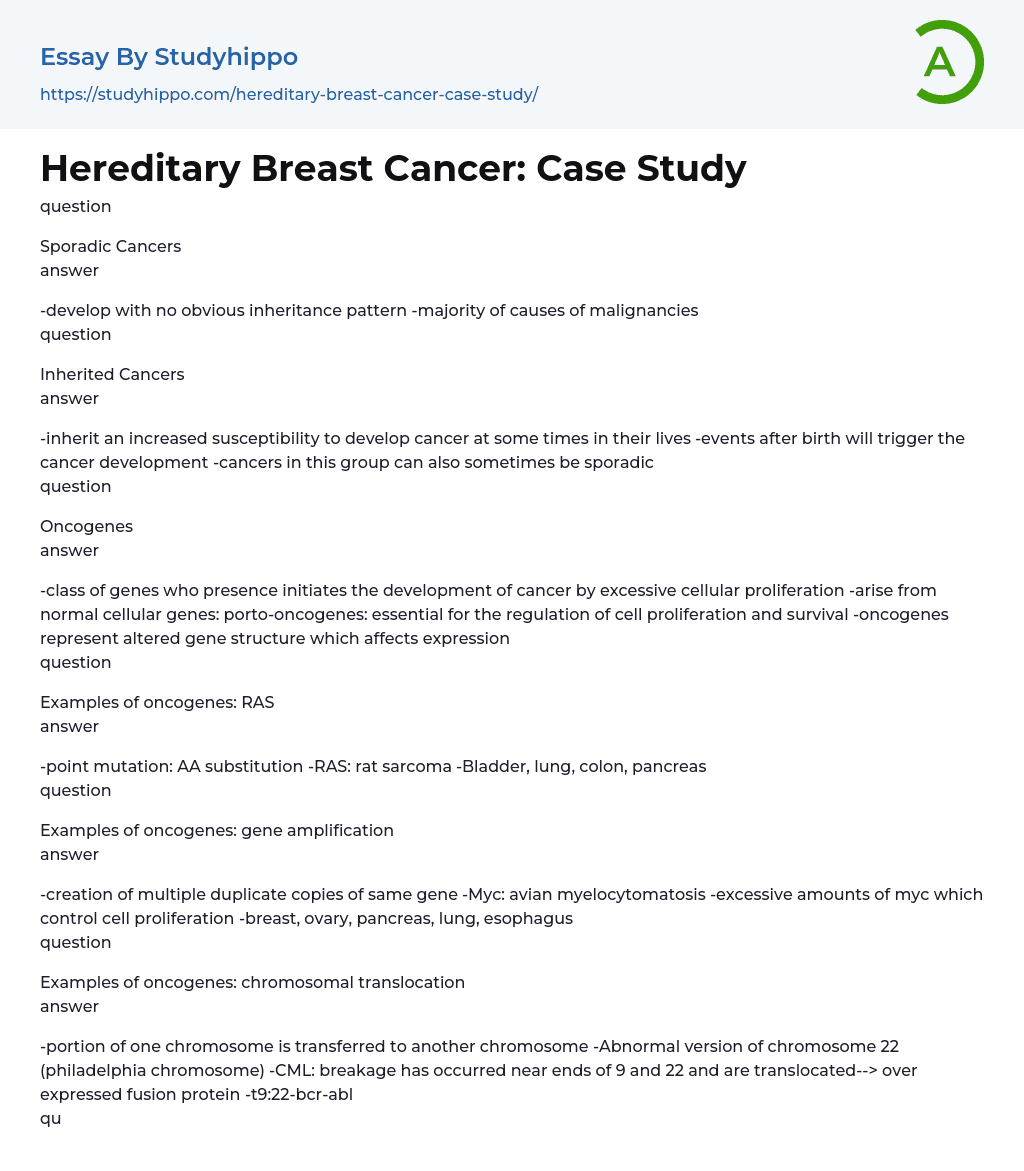Text preview
question
Sporadic Cancers
answer
-develop with no obvious inheritance pattern -majority of causes of malignancies
question
Inherited Cancers
answer
-inherit an increased susceptibility to develop cancer at some times in their lives -events after birth will trigger the cancer development -cancers in this group can also sometimes be sporadic
question
Oncogenes
answer
-class of genes who presence initiates the development of cancer by excessive cellular proliferation -arise from normal cellular genes: porto-oncogenes: essential for the regulation of cell proliferation and survival -oncogenes represent altered gene structure which affects expression
question
Examples of oncogenes: RAS
answer
-point mutation: AA substitution
...
-RAS: rat sarcoma -Bladder, lung, colon, pancreas
question
Examples of oncogenes: gene amplification
answer
-creation of multiple duplicate copies of same gene -Myc: avian myelocytomatosis -excessive amounts of myc which control cell proliferation -breast, ovary, pancreas, lung, esophagus
question
Examples of oncogenes: chromosomal translocation
answer
-portion of one chromosome is transferred to another chromosome -Abnormal version of chromosome 22 (philadelphia chromosome) -CML: breakage has occurred near ends of 9 and 22 and are translocated--> over expressed fusion protein -t9:22-bcr-abl
question
Examples of oncogenes: localized DNA rearrangements
answer
-deletions, insertions, transpositions, inversions -fusions genes and fusion proteins that stimulate cell activity -TRK (tyrosine kinase) oncogene: growth factor which permanently activates a tyrosine kinase side *hereditary colon cancer*
View entire sample
Join StudyHippo to see entire essay
class="q_and_img">question
Examples of oncogenes: Insertional mutagensis
answer
-Viral conversion of gene into oncogene -some viruses, possessing no oncogenes, if inserted next to a porto-oncogene may trigger overproduction of normally produced protein -Avain Leukosis Virus: possesses long terminal repeats (LTR) -if inserted next to the MYC can trigger overproduction *EBV, HCV, HBV, HPV, HTLV-1, KSHV
question
Gain of function mutations
answer
-protein products exhibit new or excessive activity *multiple endocrine neoplasia II* (Men II) -bening and malignant tumors of endocrine glands -inheritance of single *RET gene* (receptor tyrosine kinase)
question
Loss of Function: Rb gene
answer
-ABSENCE of the Rb gene results in hereditary retinoblastoma -Rb usually halts cell cycle at restriction point, when mutated cells grow unhindered
question
Loss of Function: P53 gene
answer
-most common tumor suppressor gene is P53 -mutated in half of all cancer cases -P53 normally gets phosphorylated when cells undergo DNA damage--> accumulation of phosphorylated P53 induces cell cycle arrest and destruction When mutated: damaged cells can proliferate
question
BRCA1 and BRCA2
answer
-proteins produced by these genes are involved in repairing damaged DNA -BRCA1 and BRCA2 mutations seen in hereditary, not so much in sporadic cancers -do not control cell proliferation, and are only indirectly related to cancer development -unlike Rb and P53 -cells deficient in either one of the brA proteins exhibit large numbers of chromosomal abnormalities--> they usually repair double strand breaks -count for 3% of all breast cancers -hundred of
mutations identified in each gene, some risker than others -higher risk of other epithelial cancers: prostate, pancreas
question
Repair of double strand Breaks
answer
1) Non-homologous end joining: ~if BRCA genes are mutated, this is the mechanism the cell uses ~very prone to mistakes--> increased risk of carcinogenic agents 2) homologous recombination: ~less prone to error because it uses DNA in unbroken homologous chromosome to serve as template for repair ~involves BRCA's *pathway activated by ATM Kinase: phosphorylates and activates more than a dozen proteins in cell control and DNA repair
question
BRCA1
answer
-located on chromosome 17q21 -ER-, Her2- -increased risk of ovarian carcinoma: 20-40% of carriers
question
BRCA2
answer
-located on 13q12.3 -ER+, Her2- -Increased risk of ovarian cancer in 10-20% -more frequent in male breast cancers
question
Penetrance
answer
-Penetrance is the % of carriers who develop the cancer -BRCA 1 and BRCA 2 penetrance can be 30-90% -lifetime breast cancer risk in women with these mutations as *high as 85%* -median age at diagnosis is 20 years earlier than women without
question
Probability of breast cancer associated with a mutation in one of these genes increases with:
answer
1) there are multiple affected first degree relatives 2) individuals are affected before menopause and/or have other cancers 3) there is a case of male breast cancer in one of the first degree relatives 4) one of the first degree family members also
develops ovarian cancer
Popular Essay Topics
- John Locke essays
- 9/11 essays
- A Good Teacher essays
- A Healthy Diet essays
- A Modest Proposal essays
- A&P essays
- Academic Achievement essays
- Achievement essays
- Achieving goals essays
- Admission essays
- Advantages And Disadvantages Of Internet essays
- Alcoholic drinks essays
- Ammonia essays
- Analytical essays
- Ancient Olympic Games essays
- APA essays
- Arabian Peninsula essays
- Argument essays
- Argumentative essays
- Art essays
- Atlantic Ocean essays
- Auto-ethnography essays
- Autobiography essays
- Ballad essays
- Batman essays
- Binge Eating essays
- Black Power Movement essays
- Blogger essays
- Body Mass Index essays
- Book I Want a Wife essays
- Boycott essays
- Breastfeeding essays
- Bulimia Nervosa essays
- Business essays
- Business Process essays
- Canterbury essays
- Carbonate essays
- Catalina de Erauso essays
- Cause and Effect essays
- Cesar Chavez essays
- Character Analysis essays
- Chemical Compound essays
- Chemical Element essays
- Chemical Substance essays
- Cherokee essays
- Cherry essays
- Childhood Obesity essays
- Chlorine essays
- Classification essays
- Cognitive Science essays
Get an explanation on any task
Get unstuck with the help of our AI assistant in seconds
New

Haven't found what you were looking for?
Enter your email to get the sample
By clicking Send Me The Sample you agree to our Terms and Conditions. We won’t send you irrelevant messages or spam.
Thanks! The sample has been sent.
Check your Inbox or join StudyHippo now to benefit from thousands of ideas
Join StudyHippo now

Unfortunately copying the content is not possible
Tell us your email address and we’ll send this sample there.
By continuing, you agree to our Terms and Conditions.


